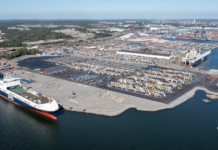
Steve Crolius, president of Carbon Neutral Consulting and a top climate advisor to former United States president Bill Clinton, has expressed his views on the shipping industry’s decarbonisation process.
In his interview with Container News managing editor Antonis Karamalegkos, Steve Crolius notes what the next steps are towards net-zero shipping and the actions needed for a wider use of sustainable fuels.
- Do you believe that the shipping industry is in the right direction regarding the decarbonization process and sustainability?
I would say yes. Based on the IMO’s initial GHG strategy, initiatives like maritime-facing aspects of the European Union’s Fit for 55 program, and recently announced plans by leading ports to implement green shipping corridors, I think the industry is unquestionably moving in the right direction. However, “moving in the right direction” does not necessarily mean “moving in the right direction with appropriate urgency”.
- What should be the next actions of shipping stakeholders to reach net-zero climate targets?
A factor that discourages companies from moving quickly is the very high level of uncertainty regarding the range of fuels and propulsion systems. It feels better to wait and see which technologies advance than to make a bet on the wrong option. In our publication, The Ammonia Report, we argue that this wait-and-see approach is actively wrong. This is because the risk of stranding assets in an unaccommodating future rises with every passing year. It is critical for companies to take advantage of the normal asset replacement cycle that is still in place before the IMO’s 2050 target for a 50% reduction in the industry’s GHG emissions.
- What actions are needed for shipping companies to widely adopt sustainable fuels, such as ammonia?
In The Ammonia Report, we argue that the best way for maritime companies to combat the uncertainty around fuels and propulsion systems is to take matters into their own hands. Specifically, companies should immediately start their own exploration of sustainable technologies with the goal of identifying the small handful of options that will make most sense for their business.
We happen to think ammonia and ammonia-fueled two-stroke engines are excellent candidates in this regard, but every company should do its own homework. Then, critically, companies should band together into like-minded coalitions that can share costs and learnings.
In fact, many coalitions have already formed to do just this. The next step is for like-minded groups to form coalitions of coalitions. In this manner, a critical mass of stakeholders can come together that can meaningfully influence, and even drive, the regulatory process.








